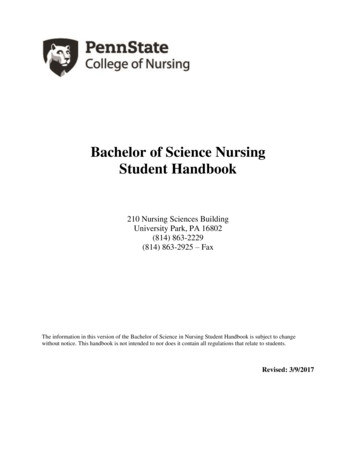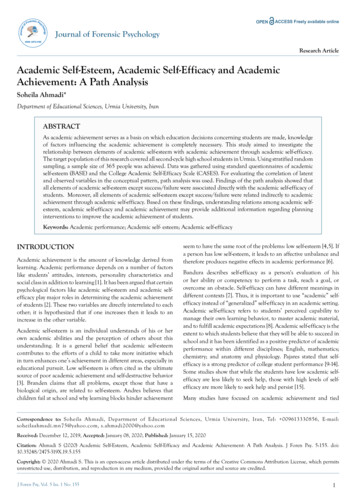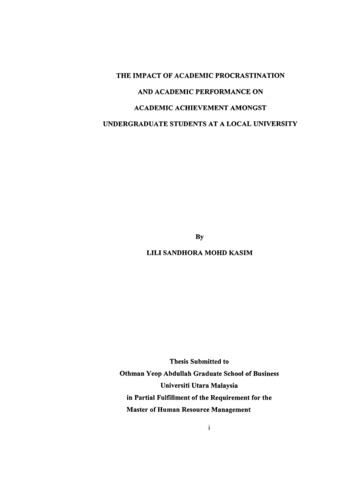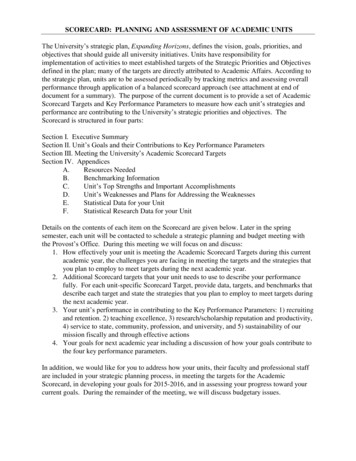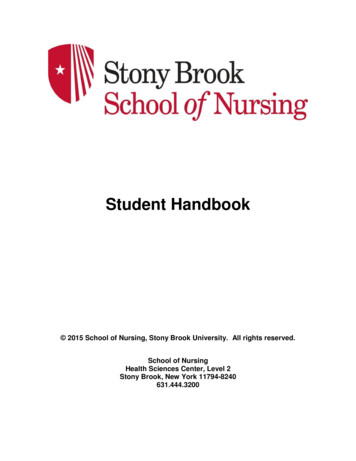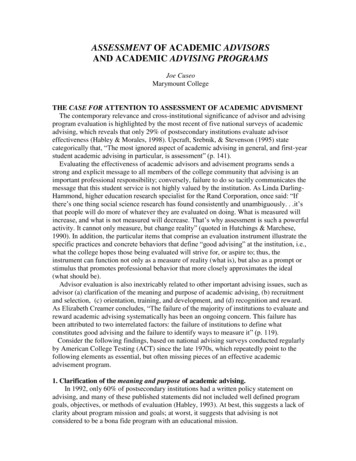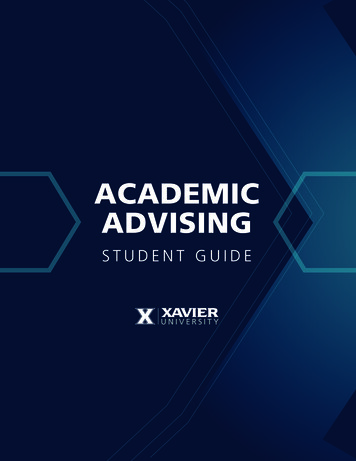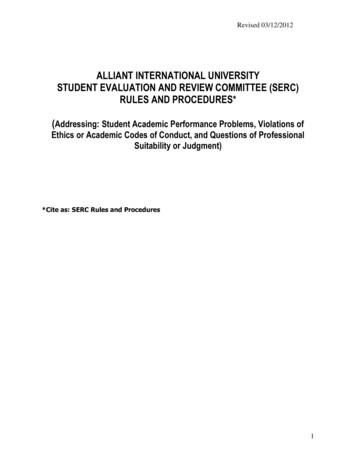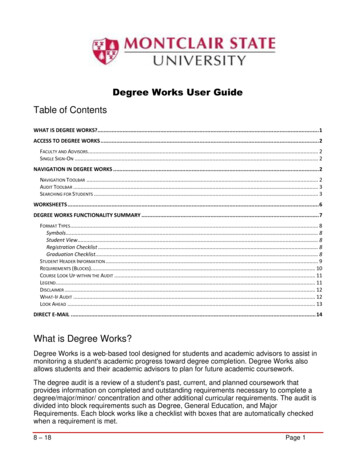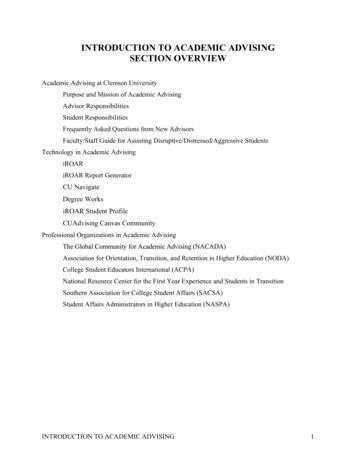
Transcription
Does a Student’s Academic Major Influence TheirPerceptions of a Human Anatomy and Physiology Courseand Ultimately Their Success in the Course?Karen L. Keller and Franklin P. HughesCorresponding Author: klkeller@frostburg.eduHAPS Educator. Vol 25 (2), pp. 13-29. Published August 2021.https://doi.org/10.21692/haps.2021.014Keller KL and HughesFP(2021). Does a Student’sAcademic Major Influence Their Perceptions of a HumanAnatomy and Physiology Course and Ultimately TheirSuccess in the Course?HAPS EducatorVol25(2), pp. 13-29.https://doi.org/10.21692/haps.2021.014
Does a Student’s Academic Major Influence Their Perceptions ofa Human Anatomy and Physiology Course and Ultimately TheirSuccess in the Course?Karen L. Keller, PhD, Franklin P. Hughes, DCDepartment of Biology, Frostburg State University, 101 Braddock Road, Frostburg, MD, 21532klkeller@frostburg.edu, fphughes@frostburg.eduAbstractStudents from a variety of majors take human anatomy and physiology courses—usually because they are required for theirprogram of study. Many students find anatomy and physiology classes academically challenging and institutions across thecountry report high failure and withdrawal rates for these courses. Although research has shown that several factors maycontribute to poor student performance, this study focused on the relationship between a student’s major and their perceptionsabout the course to investigate whether these data were reflective of student success rates. Survey data was collected fromstudents in the first semester of a two-semester, systems-based human anatomy and physiology course sequence. While theresults did not show a statistical difference in successful completion of the anatomy and physiology course related to academicmajor, interesting preferences regarding learning styles, study habits, and perceived difficulty of the course were found.https://doi.org/10.21692/haps.2021.014Key words: anatomy, physiology, academic major, learning styles, study habits, perceptionsIntroduction/BackgroundAnatomy and physiology (A&P) courses, which are required asfoundational courses for many degrees, often act as bottleneckcourses because they have some of the highest rates offailure and withdrawal from courses at the undergraduatelevel (Harris et al. 2004; Higgins-Opitz and Tufts 2014; Hopper2011; Sturges et al. 2016). Students must learn a large amountof new terminology, memorize a staggering number ofanatomical structures, and comprehend the physiologicalprocesses of multiple organ systems—typically at thefreshman or sophomore level of their education (Sturges etal. 2016; Wehrman et al. 2020). However, studies by Andertonand colleagues (2016a) and Sitticharoon et al. (2014) foundthat students who mastered the skills needed to succeedin A&P often achieved success in other college courses aswell, leading to higher overall grade point averages (GPAs).Considering the importance of GPA to acceptance into manyhealth-related programs and the fact that many programs useA&P grades specifically as a criterion for acceptance, it must beagreed that A&P courses are important for the advancement ofstudents in multiple health professional programs.Much work has been done to investigate demographic factorsthat may influence student success in A&P courses includingage, gender, and ethnicity (Gultice et al. 2015; Russell et al.2016; Schutte 2016; Gwazdauskas et al. 2014; Vitali et al. 2020).In addition, academic factors that can predict success havebeen studied, including foundational skills, placement testscores, and prerequisite requirements (Esmat and Pitts 2020:Forgey et al. 2020; Hull et al. 2016; Shaffer et al. 2018; Schutte2016; Taylor 2005; Wehrman et al. 2020). In particular, someresearchers have found that students who have completeda prior college-level anatomy or physiology course are moresuccessful than other students when the A&P class grades arecalculated (Esmat and Pitts 2020; McCleary et al. 1999; Shafferet al. 2018; Wehrman et al. 2020).Several studies have looked at the implications of a student’schosen major and how this might be involved in studentsuccess — particularly regarding prerequisite courses specificfor each major and the level of motivation to complete themajor and perhaps be successfully admitted into a healthrelated program of study (Esmat and Pitts 2020; Higgins-Opitzand Tufts 2014; Reinke 2019; Rompolski et al. 2016; Schutte2016; Sturges et. al. 2016; Wehrman et al. 2020). For example,studies regarding the exercise science major, also knownas sport science or exercise and sport science, suggest thatstudents in this major may be less successful in A&P thanstudents in other majors (Esmat and Pitts 2020; HigginsOpitz and Tufts 2014; Reinke 2019; Schutte 2016). The sameinference has been made regarding students in two- and fouryear allied health degree programs, such as nursing, dentalhygiene, and other programs with similar course requirements(Rompolski et al. 2016; Shutte 2016). Other studies have shownthat students in pre-professional majors, such as biology orhealth science, have been more successful in A&P coursescompared to their classmates in other majors (Gwazdauskas etal. 2014; Shutte 2016).continued on next page13 HAPS EducatorJournal of the Human Anatomy and Physiology Society Volume 25, Issue 2 Summer 2021
Does a Student’s Academic Major Influence Their Perceptions of a Human Anatomy and Physiology Course and Ultimately Their Success in the Course?Researchers have considered the relationship betweenacademic performance in A&P and students’ perception ofthese courses, including their motivation to study and theirinitial perception related to the difficulty of the courses (Royseet al. 2020; Slominski et al. 2019; Sturges and Maurer 2013;Sturges et al. 2016). To evaluate student perceptions, severalmeasures of study habits may be evaluated, including learningstyles or strategies, time devoted to study, study techniques,and perceived difficulty of the course, both before and aftercompletion of the course (Breckler et al. 2009; Fleming 1995;Husmann and O’Loughlin 2018; Knight and Smith 2010; Quinnet al. 2017).Learning styles are described as a set of factors, behaviors, andattitudes that facilitate learning for an individual in a givensituation (Quinn et al. 2017). The concept and existence ofstudent learning styles has been a subject of great discussionand debate in educational research, likely due to a lack ofcorrelation among teaching methods, learning styles, andstudent outcomes (Husmann and O’Loughlin 2018).Learning styles group common ways that people learn andthere are as many as 71 different learning style tools andtheories (Knight and Smith 2010; Quinn et al. 2017). Forexample, student learning may be classified according to thesensory modalities that one most prefers to use when studyingmaterial. One such classification scheme uses Fleming’sVARK instrument (Fleming 1995), which categorizes learningpreferences as visual (V), auditory (A), reading-writing (R), orkinesthetic (K). However, even its developer noted that thereare limitations to the scope, validity and reliability of the VARKquestionnaire (Breckler et al. 2009; Fleming 1995).The VARK model was originally developed as a tool to promotediscussion and reflection on learning styles (Fleming and Mills1992; Husmann and O’Loughlin 2018). Fleming reminds usthat the VARK was never meant to be a diagnostic tool. Indeed,only 15.5% of all students were able to accurately self-predicttheir own VARK result (Breckler et al. 2009; Husmann andO’Loughlin 2018). However, the VARK learning philosophyat least offers and encourages teachers to acknowledge thatthere are learning differences and to make efforts to addresssome of these differences in their classrooms by attempting awide range of teaching approaches (Dunn and Griggs 2003).At the undergraduate level there is a noticeable lack ofresearch on learning style preferences of students enrolledin gross anatomy classes. The literature in this area is mostlyfocused on learning style preferences among medical students(Anderton et al. 2016b; Knight and Smith 2010; Quinn et al.2017). The purpose of this research study was to address thefollowing research questions in the context of survey datafrom students in a variety of different majors and academicplans enrolled in the first semester of a two-semester, systemsbased A&P course sequence:1.Does a student’s major or academic plan influence theiroverall success in an A&P course?2.Does a student’s major or academic plan influence theirlearning style preferences, study techniques, and timespent studying when taking an A&P course?3.Does a student’s major or academic plan influence theirperception of the difficulty of an A&P course?MethodsStudy Context and ParticipantsThis project was conducted at Frostburg State University(FSU), which is a comprehensive, regional public liberal artsuniversity in Western Maryland. FSU is part of the UniversitySystem of Maryland (USM) and is the only four-year publicinstitution in the state west of the Baltimore-Washingtonmetropolitan area. It serves as the educational center forWestern Maryland and surrounding counties in Pennsylvaniaand West Virginia and typically enrolls 4,700 to 5,000undergraduate and graduate students each year.In this study, students enrolled in human A&P I, which is thefirst of a two-semester, systems-based human anatomy andphysiology course sequence, were surveyed at the beginningand just before completing the course in fall 2016 and fall2017. There were a total of 306 students enrolled in bothsections at the beginning of the two semesters and 282students completed the course with 24 student withdrawals.Students who took this class were required to have the firstintroductory biology course (Biology 149 at FSU), or theequivalent, before they were permitted to enroll, so most weresophomores (n 163). However, some were freshman (n 46)who had completed an equivalent course prior to enrollingat FSU, and some were juniors (n 76) or seniors (n 21).The project was approved by the Frostburg State UniversityInstitutional Review Board (FSU Project #H2016-001), andinformed consent was obtained from all participants. Studentparticipation was voluntary and anonymous and had noinfluence on course grades.Description of Survey QuestionsAll students in the class were asked to complete twoanonymous, in-person, paper surveys (Appendix 1). Therewas no time limit for either survey. The initial survey wasadministered at the beginning of the semester during thesecond week of class, and the final survey was done near theend of the semester during the second-to-last week of classbefore final exams. Note that the final survey was completedafter the course withdrawal deadline (week 10), so studentswho withdrew from A&P I in 2016 and 2017 (n 24) were notrepresented. A total of 294 students from both sections in bothyears completed the initial survey (96.08%) and a total of 248students from both sections in both years completed the finalsurvey (87.94%).continued on next page14 HAPS EducatorJournal of the Human Anatomy and Physiology Society Volume 25, Issue 2 Summer 2021
Does a Student’s Academic Major Influence Their Perceptions of a Human Anatomy and Physiology Course and Ultimately Their Success in the Course?The first set of survey questions, classified as descriptivequestions, asked about a student’s major or academic plans,career goals, and if they had taken any previous A&P coursesat the college level. At FSU, students in several different majorsand academic pathways take both A&P I and II. The majorsinclude biology, chemistry, health science (pre-medical,pre-dental, pre-physician assistant, pre-physical therapy),exercise and sport science, and athletic training. Students withother academic plans include transfer students (pre-nursing,pre-dental hygiene, pre-occupational therapy), and studentsenrolled in other majors, such as psychology, or undecidedstudents, that take the course for a variety of personal andacademic reasons. Career options that students could selectincluded personal trainer, athletic trainer, health profession atthe bachelor’s level, master’s level, or doctorate level, researchor academic position at the master’s level or doctorate level,or ‘other’ for those with other career goals or who were stillundecided.In the final survey, students were asked if they changedtheir major or academic plan and/or career goal duringthe semester. It’s important to note that the population ofstudents at FSU is represented by differences in age, gender,and cultural and educational backgrounds; however, wedid not collect demographic information regarding theseparameters on either survey to help maintain studentanonymity.The second set of survey questions, classified as preferencequestions, asked about a student’s learning style preferences,study techniques, time spent studying, and perceived difficultyof the course. Students were asked about their learning styles,or modalities, by using those outlined in the textbook used forthe course (Amerman 2015). Similar to the VARK assessment,our survey included four sensory modalities: Visual/Verbal, inwhich learners fare best when reading written material such asnotes and textbooks and looking at diagrams, illustrations, andvisual multimedia presentations (such as animations); Visual/Nonverbal where learners best understand concepts throughthe use of diagrams, illustrations, and other visual mediawithout text; Auditory/Verbal, in which a learner does wellwhen listening to lectures, presentations, or when discussingmaterial with a group (these individuals tend to prefer textbased materials rather than visuals); and Tactile/Kinestheticwhere the learner thrives in an environment where he or shecan physically manipulate a specimen (these students excel inpractical settings, including the A&P lab) (Amerman 2015).Unlike the VARK assessment, which compares the proportionof multimodal learners (those that have strong preferencesto using multiple learning styles) to unimodal learners (thosethat have a single, strong preference), the survey used in thisstudy attempted to limit students’ responses to the singlelearning style they most strongly preferred. In the final survey,students were also asked if they believed that they had adifferent learning style than they selected on the initial survey.Two additional questions asked about students’ plans to usethe same study techniques that they used for other courses,and how much time they planned to study for the A&P I coursecompared to other college courses. Students were asked thesequestions again on the final survey to see if they changed theiranswers. Finally, on the initial survey, students were askedhow difficult they thought the class would be, and on the finalsurvey, students were asked how difficult they actually foundthe class to be. This data was collected using a scale of 1-10,with 1 being very easy and 10 being the most difficult.Data AnalysisFor the purpose of evaluating the data relative to previousstudies and for statistical comparisons, students were sortedby major or academic plan into three academic groups:Kinesiology (n 120), which included exercise and sportscience and athletic training majors; Science (n 142), whichincluded biology, chemistry and health science majors; and,Miscellaneous (n 44), which included students with alternativeacademic pathways, such as transfer students, other majors,and undecided students.Student success was evaluated by comparing the finalgrades of students by their academic group and by theirclass standing. Frostburg State University uses the standardletter grading system of A, B, C, D, F, and W for students whowithdraw before the class is completed. No “ ” or “-” additionsto the letter grades are reported. Students who received D, F,or W grades were considered unsuccessful in the course.Graphic results comparing initial and final survey data fromthe three academic groups are reported as percentages toaccount for the reduced number of students completing thefinal survey. Chi-square tests for independence were used tocompare initial and final survey responses between the threeacademic groups and to compare student success betweenthe three academic groups and by class standing. Significancewas set at p 0.05.ResultsDescriptive QuestionsAcademic Major or PlanThe percentage of students enrolled in each major oracademic plan did not significantly change (p 0.91) fromthe initial to the final surveys (reported as initial percent; finalpercent). The most popular majors or plans were exerciseand sport science (31.3%; 26.2%) and health science (27.0%;28.5%), followed by biology (18.3%; 18.8%), transfer students(8.7%; 9.6%), athletic training (7.3%; 8.5%), ‘other’ (5.3%; 6.5%),and chemistry (2.0%; 1.9%). It should be pointed out that in2016 and 2017 when the surveys were completed, the athletictraining major was offered at the bachelor’s level at FSU. It hassince become a master’s level program and students enroll incontinued on next page15 HAPS EducatorJournal of the Human Anatomy and Physiology Society Volume 25, Issue 2 Summer 2021
Does a Student’s Academic Major Influence Their Perceptions of a Human Anatomy and Physiology Course and Ultimately Their Success in the Course?the exercise and sport science undergraduate major to preparethem for the graduate level athletic training curriculum. Thefact that there were no significant changes in number forany major from the initial to final surveys justified our use ofacademic groups for statistical analyses.Career GoalsOverall, the most popular career goals in both the initial andfinal surveys (reported as initial percent; final percent) werethose in the health professions, particularly at the doctoratelevel (51.7%; 46.6%) and master’s level (20.5%; 19.0%). Thesewere followed by health professions at the bachelor’s level(7.9%; 11.5%), ‘other’ (6.3%; 8.6%), personal trainers (6.9%;6.1%) and athletic trainers (4.1%; 5.7%). Very few studentsselected research or academic positions at the doctorate(1.6%; 1.1%) or masters levels (0.9%; 1.4%). Again, thepercentages in each career goal did not change significantly (p 0.59) from the initial to the final survey.When comparing the career goals of each academic group,there were differences in the popularity of the options. Forexample, only students in the Kinesiology group selectedpersonal and athletic trainer careers. The few students whoselected one of the research or academic options werein the Science group and the majority of students whoselected health professions at the bachelor’s level were in theMiscellaneous group. Students in both the Kinesiology andMiscellaneous groups also selected ‘other’ as possible careeroptions.Previous Anatomy and Physiology Courses at the College LevelStudents were asked if they had taken a previous A&P courseat the college level and the majority replied that they had not.When comparing the responses by academic group, therewas a statistical difference (p 0.003) with 84.3% of Sciencestudents reporting that they had not taken a prior A&P collegecourse, compared to 69.6% of the Kinesiology students and62.2% of the Miscellaneous students. Students were not askedwhether the prior A&P course was at FSU or another institutionor whether they were repeating the course. No questions wereasked about prior A&P courses taken in high school.Perspective QuestionsLearning Style PreferencesThe most popular learning style preference (LSP) in boththe initial and final surveys across all three academic groupswas Visual/Verbal. More than half of all students selectedthis modality on the initial survey. In the final survey,the percentage of Kinesiology students who preferredVisual/Verbal fell about 7% with a smaller decline in theMiscellaneous group. This is in contrast to the Science group,where nearly 65% of students on the final survey preferredVisual/Verbal compared to 50% on initial survey. The secondmost common LSP was Tactile/Kinesthetic on both surveys inall three academic groups, with Kinesiology students showinga slightly stronger preference for this learning modality ascompared to the Science and Miscellaneous groups althoughthe preference did increase in the Miscellaneous group in thefinal survey. Coming in third and fourth, respectively, for boththe Science and Miscellaneous groups were Auditory/Verbaland Visual/Nonverbal on both surveys. In contrast, students inthe Kinesiology group preferred Visual/Nonverbal over Audio/Verbal in both surveys (Figure 1).Figure 1. Learning style preferences by academic group expressed as percent of students completinginitial and final surveys.continued on next page16 HAPS EducatorJournal of the Human Anatomy and Physiology Society Volume 25, Issue 2 Summer 2021
Does a Student’s Academic Major Influence Their Perceptions of a Human Anatomy and Physiology Course and Ultimately Their Success in the Course?It is noteworthy that, although asked to provide “whichmethod of learning best describes your learning style” on bothsurveys (reported as initial percent; final percent), a proportionof students in all three groups selected multiple learningstyles. Although this increase was not statistically significant(p 0.44), the largest increases in multimodal learners werein the Science (9.9%; 18.8%), and Miscellaneous (9.5%;16.7%) groups, where those selecting multiple learning stylepreferences nearly doubled. The percentage of students in theKinesiology group selecting multiple learning styles (12.1%;14.4%) was similar in both surveys.Study TechniquesIn the initial survey, students were asked if they planned touse the same study techniques for A&P I that they had usedin other college classes. While nearly 60% of all studentspredicted that they would, in the final survey, only about 40%of all students did ultimately report using the same studytechniques in A&P I as they had in other college courses(Figure 2). Although the percentage of Science studentsappeared most likely to maintain the same study techniques,there was no statistical difference (p 0.052) when comparingtheir initial and final responses. Meanwhile, over 20% ofKinesiology students reported using different study habitsin A&P I than they had predicted, which was statisticallysignificant (p 0.0007). A similar trend was seen with theMiscellaneous students, which was also statistically significant(p 0.04).Study TimeIn the initial survey, students were asked to predict theamount of study time they would devote to A&P I comparedto other college courses they had taken. Students in allacademic groups overwhelmingly reported (80% or above)that they would spend more time studying for A&P I than theyhad for other courses. No student predicted that the timewould be less. Less than 10 per cent of students in each of theKinesiology and Miscellaneous groups predicted that theywould spend about the same time studying for A&P I as otherclasses whereas almost 20% of Science students believed thatthey would invest the same amount of time (Figure 3).When asked on the final survey how much time they actuallyspent studying A&P I compared to other courses, over 90%of Kinesiology students did report studying more for A&PI than for other classes and those that invested about theFigure 2. Study techniques (same or different) compared to other college courses by academic group.Percent of students completing initial and final surveys.continued on next page17 HAPS EducatorJournal of the Human Anatomy and Physiology Society Volume 25, Issue 2 Summer 2021
Does a Student’s Academic Major Influence Their Perceptions of a Human Anatomy and Physiology Course and Ultimately Their Success in the Course?same amount of time increased slightly (Figure 3). Studentsin the Miscellaneous category more accurately predicted thatthey would spend more time studying A&P I, although somestudents did report actually spending less time with A&P I thanother courses. Students in the Science group reported thatthey spent less time studying A&P I compared to other classesthan they initially predicted. However, within the academicgroups, there was no statistical difference between the initialand final surveys (Kinesiology p 0.18; Science p 0.30;Miscellaneous p 0.67).Figure 3. Study time (more, less or the same) compared to other college courses by academic group.Percent of students completing initial and final surveys.continued on next page18 HAPS EducatorJournal of the Human Anatomy and Physiology Society Volume 25, Issue 2 Summer 2021
Does a Student’s Academic Major Influence Their Perceptions of a Human Anatomy and Physiology Course and Ultimately Their Success in the Course?Perceived Difficulty of the CourseIn the initial survey, students were asked to rate on a scale of1 to 10 how difficult they expected the course to be with 1being very easy and 10 being most difficult. Similarly, in thefinal survey, students were again asked to rate the difficultyof the course and whether they felt the course was easier orharder than they had thought it would be. The most frequentlychosen numerical answer, or mode, on both the initial andfinal surveys among all academic groups was 8/10. This resultis interesting considering that 60% or more of students fromall three academic groups stated that they felt the class washarder than they thought it would be.Student Success RatesAs reported previously, a total of 306 students were enrolled inboth lecture sections of A&P I in 2016 and 2017. A total of 95students (31.0%) were unsuccessful and either withdrew ‘W’ orreceived a ‘D’ or ‘F’ grade for the course. When comparing theDWF grades by academic group (close to 30% for each group),no statistical significance (p 0.90) was found (Figure 4).Figure 4. Class composition (kinesiology, science, other) and percent students with DWF(grade of D, withdrew from course, grade of F) by academic group and as percent of theentire A&P class.continued on next page19 HAPS EducatorJournal of the Human Anatomy and Physiology Society Volume 25, Issue 2 Summer 2021
Does a Student’s Academic Major Influence Their Perceptions of a Human Anatomy and Physiology Course and Ultimately Their Success in the Course?The majority of students in A&P I were sophomores, followedby juniors, then freshman, and, finally, seniors. Althoughcomprising only 15% of the course, freshmen accountedfor nearly a quarter of the course DWF grades. Almost 48%of freshmen were unsuccessful in the course, followed bysophomores at just over 33% and seniors and juniors at about19% (Figure 5). Class-standing was found to be correlated withsuccessful completion of this A&P course (p 0.004). However,students were not asked to self-identify by class standing sono survey data could be directly related to this parameter.Figure 5. Class composition by standing (freshman, sophomore, junior, senior) andpercent of students with DWF (grade of D, withdrew, grade of F) by class standing and aspercent of the entire A&P class.DiscussionDescriptive QuestionsAcademic Major or PlanAs is the case with many institutions, the A&P I course at FSU isa required course for students in a variety of academic majorsand plans, so we were interested to see if students changedtheir major or plan after taking the course. While somestudents did change their major or plan during the semester,the numbers were not statistically significantCareer GoalsThe most popular career goals in both surveys were those inthe health professions, which is not unexpected from studentsenrolled in a human anatomy and physiology course. Inaddition, certain career goals that were selected exclusivelyor almost exclusively by specific academic groups also wereexpected. Even though there were no statistically significantdifferences between the surveys, a trend toward a decrease inselecting the option of health profession at the doctorate levelby Kinesiology and Science students may indicate that somestudents were reconsidering their career options after takingthe A&P I class.continued on next page20 HAPS EducatorJournal of the Human Anatomy and Physiology Society Volume 25, Issue 2 Summer 2021
Does a Student’s Academic Major Influence Their Perceptions of a Human Anatomy and Physiology Course and Ultimately Their Success in the Course?Previous Anatomy and Physiology Courses at the College LevelWhile most of our students had not taken a previous A&Pcourse at the college level, there was a statistical differenceregarding the number of students by academic group.Unfortunately, we do not know if the students who had takena prior college level A&P course were repeating the course orhad taken a different A&P course, such as a single-semester,essentials of A&P course. It is noteworthy that there was nosignificant difference in student success rates for any of theacademic groups which suggests that a prior A&P course atthe college level was not helpful in this regard. It is unclear,then, whether our results agree or disagree with other studies(Esmat and Pitts 2020; McCleary et al. 1999; Shaffer et al. 2018;Wehrman et al. 2020).Perspective QuestionsLearning Style PreferencesOur findings on preferred learning styles among students inA&P I are contrary to other studies reporting that a majorityof students enrolled in A&P prefer a kinesthetic, or handson approach, to learning (Anderton et al. 2016b; Breckler etal. 2009; Carnegie 2008; Hsieh et al. 2012; Meehan-Andrews2009). Students in our study most commonly selected a Visual/Verbal learning style ahead of a Tactile/Kinesthetic approach.However, only about 5.6% of students overall noted that theyidentify with a different learning style preference altogetherthan what they had indicated on their initial survey. It wasnoted that students in the Kinesiology and Miscellaneousgroups had learning style preferences that more closelymirrored each other on the final survey as compared tothe Science group.
introductory biology course (Biology 149 at FSU), or the equivalent, before they were permitted to enroll, so most were sophomores (n 163). However, some were freshman (n 46) who had completed an equivalent course prior to enrolling at FSU, and some were juniors (n 76) or seniors (n 21). The project was approved by the Frostburg State University
